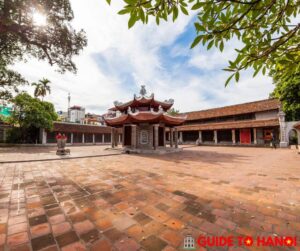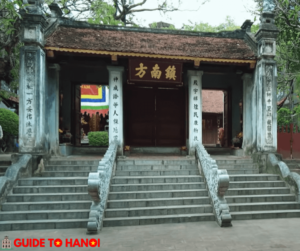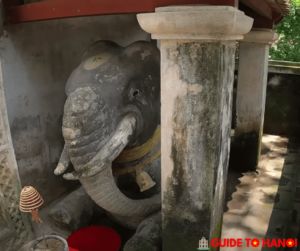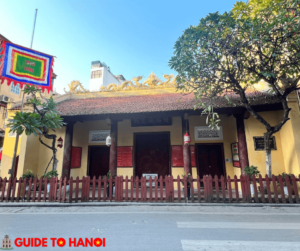Hai Ba Trung Temple
Embark on a journey to the Hai Ba Trung Temple (Hai Bà Trưng Temple), where tradition meets a touch of cheekiness.
Nestled near Hoàn Kiếm Lake, this temple is not your average place of worship—it’s a rendezvous with the lively spirits of the Trưng Sisters.
Cult of Independence: Rain Spirits and Rebellious Vibes
Established in 1160 by the visionary Lý Anh Tông, the temple’s roots dig deep into the soil of Vietnamese independence.
The Trưng Sisters, appearing as rain spirits, set the stage for a cultural uprising against the backdrop of Vietnam’s liberation from the Third Chinese domination.
Altar Drama: Not Your Ordinary Sisters’ Tale
Step into the temple to witness a spectacle—the altar display showcasing the Trưng Sisters’ dramatic demise.
Forget the conventional suicide narrative; here, their violent end takes center stage, adding a twist to the sisters’ legendary story.
Dong Nhan Delight: A Cluster of Cultural Treasures
Explore more than just a temple—Hai Bà Trưng Temple, also known as Dong Nhan Temple, is part of a cultural trifecta.
Joined by Vien Minh Pagoda and Dong Nhan communal house, it forms a relic cluster recognized as a unique national treasure.
Floating Statues and Royal Drama: The Legend Unveiled
Dive into Hai Bà Trưng’s founding legend, involving a floating stone statue, a daring rescue, and a sacred transformation.
Discover how this statue, embodying the sisters’ energy, found its home along the Nhi Ha River, shaping the temple’s rich history.
Moving Temples and Soil Erosion: A Royal Relocation Tale
The temple has seen its fair share of moves, navigating soil erosion and royal decisions.
Originally on the riverbank, it moved to the Former Martial Arts area during Gia Long’s 18th year.
It remains the capital’s most sacred Hai Bà Trưng temple despite the changes.
Historical Echoes: Recognized and Revered
Since 1962, the Hai Bà Trưng Temple has worn the badge of honor as a Historical-Cultural Monument.
Its echoes resonate through the centuries, weaving a reverence and cultural significance tale.
Visit Hai Bà Trưng Temple Today: Where Legends Come to Life
Immerse yourself in Hanoi’s vibrant history, legends, and cultural richness at the Hai Bà Trưng Temple.
From the dramatic altar displays to the captivating legends, this temple invites you to explore the heart of Vietnamese heritage.
Don’t miss the chance to witness the spirited allure—plan your visit today!
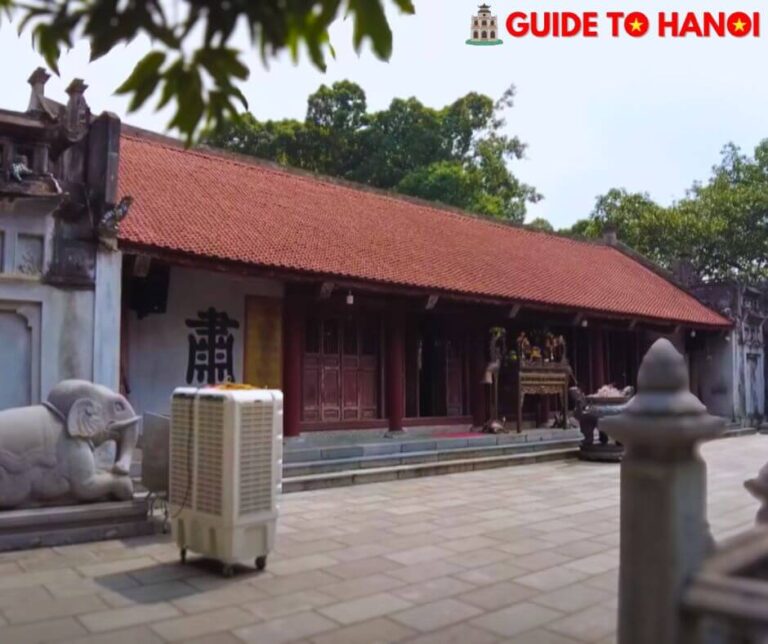
Hai Ba Trung Temple Summary
| Section | Highlights |
|---|---|
| Location | 12 Huong Vien Street, Dong Nhan Ward, Hai Ba Trung District, Hanoi |
| Legend of Founding | Stone statue floating on Nhi Ha river, transformed by sacred energy of Hai Ba Trung |
| Relic Cluster | Hai Ba Trung Temple, Vien Minh Pagoda, Dong Nhan Communal House |
| Historical Significance | Recognized as a Historical-Cultural Monument since 1962 |
| Altar Display | Showcases the violent death of Trưng Sisters, challenging traditional narratives |
| Relocation History | Moved to Former Martial Arts area during the 18th year of Gia Long |
| Current Status | Remains the most sacred Hai Ba Trung temple in the capital city of Thang Long |
Where is the Temple of the Trung Sisters?
The Temple of the Trưng Sisters, or Hai Bà Trưng Temple, is at 12 Huong Vien Street, Dong Nhan Ward, Hai Ba Trung District, Hanoi.
What is the Legend of the Trung Sisters?
The legend recounts a floating stone statue on the Nhi Ha River, transformed by the sacred energy of Hai Ba Trưng after committing suicide on the Hat River, inspiring the foundation of the temple.
Is the Trung Sisters Real?
Yes, the Trưng Sisters, Trưng Trắc and Trưng Nhị are historical figures who led a rebellion against Chinese domination in the first century AD.
Why are the Trung Sisters Important?
The Trưng Sisters are revered for their pivotal role in Vietnamese history, leading a significant uprising against foreign rule and symbolizing the spirit of resistance and independence.
Address:
- 12 Huong Vien Street, Dong Nhan Ward, Hai Ba Trung District, Hanoi
Opening Hours:
- Daily: 8:30-17:00
Entrance Fee:
- Free

